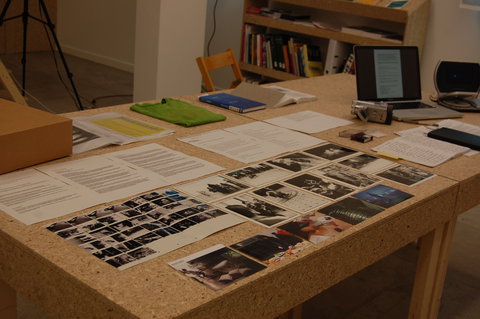
During the practice-led phase of research, the performances given in the model archive and at the conference gave rise to a wealth of artefacts. These were mostly produced or commissioned by us, the project participants. We then made a selection of the artefacts to examine in-depth in our case studies. Unlike most other performance research projects, rather than analysing established, canonised works, we decided to work with examples of contemporary performance art in whose creation and ‘documentation’ we were directly involved.
This naturally raised the problem of maintaining an objective distance. Alongside our function as documentarists, we were also eyewitnesses of the performances. But to analyse the artefacts effectively we had to maintain a critical distance to the objects examined which, in view of the short periods separating the tasks and our personal preferences, was not always easy to do. In order to give this aspect due attention and to avoid confusion in view of the amount of material, we limited ourselves to examining a selection of exemplar performances and artefact types. (Link with Related docs)
For these case studies, we based our research on methods of source criticism used in media and art theory, examining the artefacts for their transmission intensities. Although we were at pains to do this as objectively as possible, we are aware that by writing our own texts we were acting interpretatively, creating transcriptions of the performances.
When analysing transmission, we applied concepts of art and cultural theory which enabled us to differentiate between the concept or idea of a performance, its implementation and the transmissions conveyed in the artefacts from a ‘historical’ perspective. Having access to the artists’ written concepts proved very useful here. As well as these concept texts, we also examined the following artefacts: photographs (single images and series), video and audio recordings, written and oral eyewitness reports and performance texts.
To facilitate making the selection, after the model archive and conference, we wrote short descriptions of the performances from which we distilled the topics and discourses which correlated with our research questions. Furthermore, we classified the different performances in terms of their characteristics. In order to avoid placing them in a hierarchical structure which, in our opinion, cannot hold for the field of performance art, we decided to use the concept of equal ‘genres’ which exist alongside each other. Each of the ‘genre terms’ is based on the performances’ parameters of content, form and structure. We are aware that the terminology chosen and the classifications applied reflect our own perspectives. The aim of our inquiry is to show which artefacts and combinations of artefact are suited to the transmission of certain performance genres.
The selection procedure for the case studies of performances took place in two steps. We took our individual research interest as a starting point. Subsequently, we checked the extent and quality of the available artefacts and adjusted the selection if necessary. Each project participant then chose two case studies.
In the case studies, we first compared different artefacts, types of artefact and recording methods, or analysed their respective media-specific transmission intensities. In this context, we looked for correlations with or deviations from the findings we had already gained from the interviews and linked these with discourses of performativity, mediality, memory / archive / recollection, the documentary and the image-space relationship. We did not go into the role of physical transmission in performance art, since discourse on the body in performance theory has been extensively (and exhaustively) discussed elsewhere. It would however be profitable for a successor project to examine the specific function of body transmissions (e.g. in the form of physical habits, gestures, dance), i.e. so-called body-to-body transmissions, more closely. Performance theorist Rebecca Schneider published observations in this field in 2001.[1]
Drawing on findings from the interviews, we established the following key points of inquiry for analysing the transmission function of artefacts:
• the informative level, i.e. the aspects of content, form, concept and use implicit in the work process
• the dimension of perception, i.e. temporal, spatial, atmospheric, visual, auditory, olfactory / textural and physical perception processes
• the audience dimension, i.e. spectators’ reactions and affective participation
• the contextual level, i.e. what the artefact tells us about the institution(s), site-specific conditions and (arts-)political and historical situation they were made in / are held in.
[1] Cf. Schneider, Rebecca, Performance Remains, Performance Research. 6.2 On Maps, Dartington, UK 2001, pp. 100-108 digital (www.routledge.com).